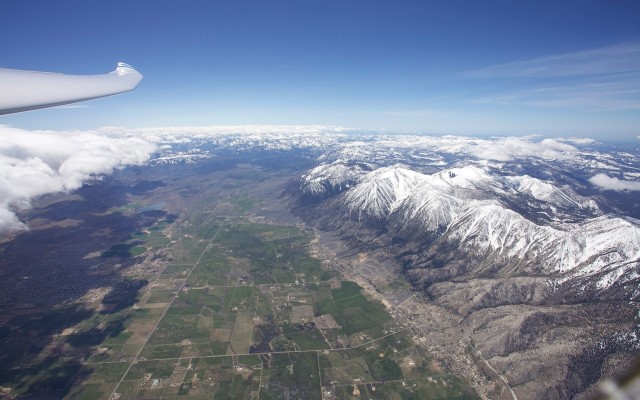
Another amazing photo by Gordon Boettger, from 26,000 feet over the Carson Valley, during a glider wave flight
Let’s pick up where we left off in Gone Gliding, Part Two, shall we?
We’re at Minden-Tahoe Airport in Soaring NV’s LS4 glider, hooked up to the Piper Pawnee towplane, and just starting our takeoff roll. Spencer, our ground crew, runs alongside the glider for a few feet while holding the wingtip. The ailerons are alive in a couple of seconds, and I hold the wings level with the stick, while steering along the runway centerline with the rudder pedals.
With the single main wheel rumbling under my seat, we accelerate quickly as we’re hauled along the runway. A little bit of forward stick gets the LS4’s tail wheel off the ground, and then I move the stick ever-so-gently rearwards. The glider levitates, and we carefully hold position just a few feet in the air, right behind the tow plane. Now that we’re airborne, we’re less drag for the Pawnee, and Silvio lifts off.
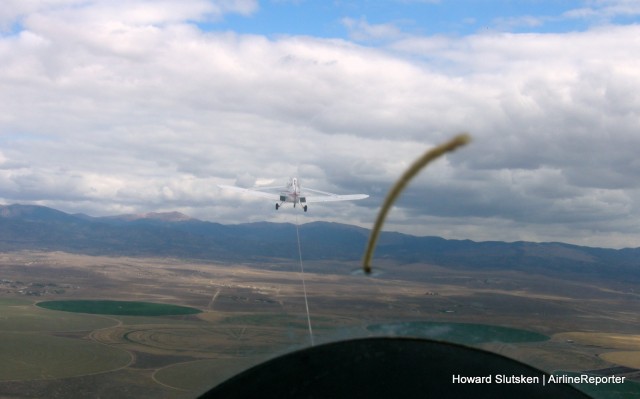
On tow behind the Pawnee, heading east, over the Carson Valley
I’m primed for a possible rope break, and glance at the altimeter as we cross the end of the runway. It shows a bit under 5,000 feet, and I call out ’œ200 feet!’ We’ve passed the first ’œgate’ at 200 ft above the ground, and if the rope breaks, we can now safely fly a 180-degree turn to land downwind on the runway. Silvio starts a climbing left turn to cross over the airport, and we’re nicely locked in, on tow. The feeling is something like being pulled behind a ski boat, and I’m not even thinking about what I’m doing to the controls, just reacting and flying. Heading east, and crossing over Runway 34, I relax. If the rope breaks now, we’re high enough to easily complete a normal pattern and landing.
As we continue to climb, I call Silvio and tell him that we’d like to ’œbox the wake,’ which is great practice while on tow. He acknowledges, and I start the maneuver by climbing a bit above the towplane, while keeping the rope taut. I stop for a moment, then fly the glider to the right, and stop again at the first corner of the ’œbox.’ Descend a bit, and stop below the towplane at the next corner. Now it’s a slide across the bottom of the box, stopping at the third corner.
Gentle nose up, keep the rope taut, climb above the towplane, and stop at the last corner. Then slide back behind Silvio, hold, and drop back down into the normal tow position, lining up the Pawnee’s horizontal stabilizer with its wing. Smooth, smooth, smooth, all the way around, and I don’t think that I yanked the Pawnee’s tail, even once. I realize that I’m grinning ’“ nailed it!
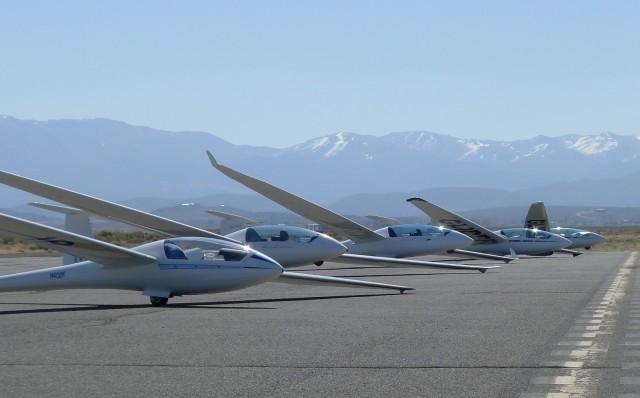
Soaring NV’s gliders at Minden-Tahoe Airport – the LS4, two Duo Discus, two ASK-21s
Photo: Soaring NV
I’ve been waiting for you!
I’m glad that you decided to come along with me for a flight in Soaring NV’s LS4 glider. I promised you a ride in Gone Gliding, Part One, didn’t I? Yes, the LS4 is just a single-seater, so we’ll use a ’œmind-meld’ for you to enjoy the flight. Let’s hop into a golf cart with Spencer, who’ll be our ground crew, and head over to the glider staging area near the threshold of Runway 30, here at Minden-Tahoe Airport (MEV).
While Spencer drives us over, he’ll be making radio calls on his handheld to update air and ground traffic with our progress along the taxiways and across the runways. MEV doesn’t have a control tower, and it’s important that we communicate as we go. So I’ll tell you what I’ve been up to, before you arrived.
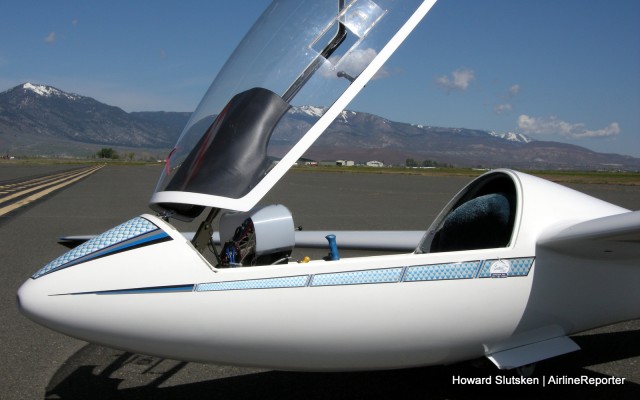
The LS4 waits for us in the staging area near the threshold of Runway 30. I only left the canopy up long enough to quickly take this photo on a no-wind day – a strong breeze could smack it down and damage it.
I’ve checked the weather, and had a good look at the soaring forecast. The National Oceanic and Atmospheric Administration (NOAA) publishes a daily forecast for the Reno area that gives glider pilots an idea of the lift, temperatures, and winds aloft for the day. It’s a beautiful afternoon in the Carson Valley, warm, with just a few puffy cumulus clouds out there around 14,000 feet above sea level (ASL). I’ve also talked with a couple of pilots who’ve just landed, and they told me that there’s some booming thermals just a couple of miles east of the airport. Great!
Spencer towed the glider over from the ramp earlier today, and I’ve done the pre-flight. That included a walk-around inspection and a full test of the flight controls and connections. I’ve also made sure that the oxygen cylinder in the glider is full, the battery is properly connected, and adjusted the seatback, because it can only be moved before you get in the cockpit. The seat bottom doesn’t move, but the rudder pedals are adjustable, and I’ve moved them into position. The last pilot must have been a lot taller than me. Spencer hooked up the GPS logger, which will keep track of our position, speeds, and altitudes of our flight. Once we’re back on the ground, we’ll transfer the data to a computer, and review the flight.
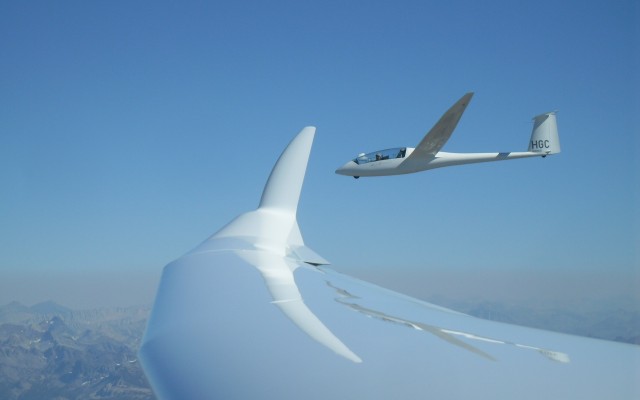
Gliders flying in formation near Lake Tahoe – Photo: Soaring NV
If you’ve ever flown into Reno-Tahoe International Airport (RNO) when the winds are howling out of the west, you know that the approach and landing can be’¦sporty. In fact, it sometimes gets so turbulent that the mainline jets head for Sacramento International Airport (SMF), leaving RNO to Alaska Airlines’ Bombardier Q400 turboprops, which can use RNO’s short crosswind runway. I’ll happily fly into RNO from SEA on the AS Q400s on those bouncy days.
The bumps can mean that conditions are great for soaring. Yes – I’m a glider pilot, and the region around Reno is world-famous for those who love to fly without an engine. It’s an amazing sensation, soaring in our ocean of air. Some flights are like a dream – I just have to think about moving the control stick, and off I go, hunting for lift, as if the glider’s wings are attached to my shoulders.
When you think of gliding, you might have an image of a pilot running towards the edge of a cliff, ready to leap into the air while hanging from a fabric-covered wing. Yes, there are those out there who enjoy hang-gliding, in aircraft that are at the light and slow end of the soaring spectrum. Other than a lack of an engine, they don’t have much in common with a modern high-performance glider.




